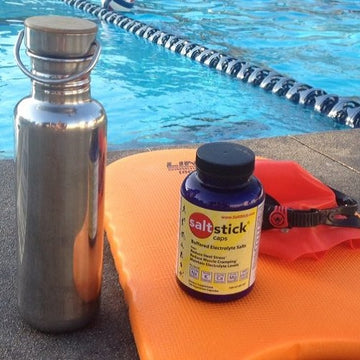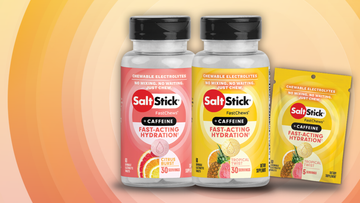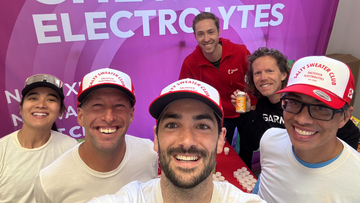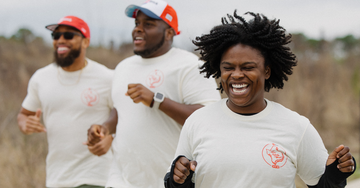
It is commonly understood that water and electrolytes are essential for maintaining peak performance in endurance events. We know that you are dutifully grabbing your sports drinks and mixes during your run and bike sessions, but did you know hydration practices are also crucial to long distance swimming?
Long-distance swimming (or swimming events that extend beyond 2.4 miles) can require continuous swimming of three or more hours. Due to the increased challenge, these events are becoming popular across the endurance world. Additionally, day-long swim-run events, such as the
ÖTILLÖ, are also growing in popularity.
ÖTILLÖ (Swedish for "Island to island") is a one-day swimrun race in the archipelago of Stockholm, Sweden, covering 75 kilometres (10K open-water swimming and 65K trail-running), and SaltStick is used by athletes to complete this enormous endurance challenge.
Tweet this post: How to Hydrate for Long-Distance Swimming: http://bit.ly/1t2uvbF via @SaltStick
Fundamentally, events of this length require a different approach to fueling and hydration, similar to the way in which marathon nutrition is quite different from fueling for a 10K. If you are considering tackling a long-distance swim this year, we think you will find this blog post helpful.
Yes, you do sweat when swimming:
A common myth is that swimmers do not sweat because they are immersed in water, thereby removing the need for perspiration. However, this is not true, and it can deceive swimmers into believing they are not becoming dehydrated as they perform their workouts.
The research is fuzzy about the exact amount of sweat lost through swimming; however, all researchers agree that we do sweat in the pool. Swimming is an aerobic activity, which raises core temperature. Even though a lot of excess heat is conducted away from your body through the pool water, a rise in core temperature triggers your sweat glands to do what they are meant to do: release sweat. You just don’t notice because you are immersed.
Using electrolytes to improve swimming performance:
We previously published
a blog post about
a study in Spain that examined the effects of electrolyte supplementation on endurance performance. Check out the
original blog post for greater detail, but the bottom line is this: Athletes who used electrolyte tablets -- in addition to sports drinks -- finished a medium-distance triathlon on an average of 26 minutes faster than athletes who only consumed sports drink. The effects in stamina increases were particularly pronounced later in the race, when athletes typically begin to feel the effects of dehydration.
We know what you are thinking: If the effects of electrolyte supplementation do not take effect until the later stages of a race, how can it improve swimming performance, given that almost all endurance athletes never spend more than 90 minutes in the pool at one time?
The answer is highly dependent on training duration: When swim times go beyond 90 minutes, electrolytes play a very important factor. Marathon swimming, as it is commonly known, can involve anywhere from two to 36 hours of swimming at a time. (On the extreme end, consider
Diana Nyad, whose record-breaking swim from Cuba to Florida took 53 hours.) Similar to running and cycling, it is impossible to maintain peak performance for that long without refueling.
So while electrolyte supplementation may not make much of a difference for the average triathlete looking to improve swim times over the sprint or Olympic distance, it could significantly improve the performance of the marathon swimmer.
How am I supposed to eat and drink while long distance swimming?
As you can imagine, one of the toughest parts to refueling during a marathon swim is the difficulty in storing food and water. Unlike runners, swimmers cannot hold a water bottle in their hand. Various
tips and
tricks exist throughout the swimmer world, but your ability to refuel in a race is going to come down to exactly what you would think: lots and lots of practice.
You will need to practice both what you are eating and how you are eating it. You will need to spend several hours swimming with your crew to get used to grabbing a bottle and eating/drinking while treading water. As you make your way through something like a 12-mile swim, your strength and dexterity are going to decline, so it is important to know your routine beforehand.
That said, here are a few tips we have found helpful to keep things moving smoothly during the swim:
-
Use a wide-mouth plastic bottle, not a squeeze bottle: It takes longer to drink from a squeeze bottle; whereas a wide-mouth bottle will allow you to take three or four long gulps quickly.
-
Use a thin bottle: As your strength fades, it will get harder and harder to grip a large bottle.
-
Use rubber bands: Attach gels and other food/electrolyte sources (including SaltStick Caps) to the water bottle with a rubber band. This makes it easy to throw one “package” into the water that the swimmer can easily deconstruct.
-
Practice, practice, practice: We said it before, but it is worth saying again: The amount of time you spend practicing and preparing for your race is directly correlated to how well you will do in the event. Make sure you and your crew get in several practice sessions, and it will feel effortless on race day. This will allow you to focus on the hard part: getting through the actual swim.
-
Consider a liquid-only diet: In addition to easier digestion, you may find it less difficult to consume calories and liquid from a bottle instead of attempting to wolf down solid food. Note that SaltStick Caps PLUS are 100 percent soluble, and you can make your own sports drink by dissolving the contents of a capsule or two in a water bottle. In addition to providing a full spectrum of electrolytes, Caps PLUS offers a boost of caffeine, which can help power you through your Herculean swim effort.
Conclusion:
Just like water and electrolytes are important in running and cycling, proper hydration practices are necessary to achieving peak performance in swimming, especially in long distances. Practice proper hydration techniques in training, and you will be ready for race day!

 It is commonly understood that water and electrolytes are essential for maintaining peak performance in endurance events. We know that you are dutifully grabbing your sports drinks and mixes during your run and bike sessions, but did you know hydration practices are also crucial to long distance swimming?
Long-distance swimming (or swimming events that extend beyond 2.4 miles) can require continuous swimming of three or more hours. Due to the increased challenge, these events are becoming popular across the endurance world. Additionally, day-long swim-run events, such as the ÖTILLÖ, are also growing in popularity.
ÖTILLÖ (Swedish for "Island to island") is a one-day swimrun race in the archipelago of Stockholm, Sweden, covering 75 kilometres (10K open-water swimming and 65K trail-running), and SaltStick is used by athletes to complete this enormous endurance challenge.
Tweet this post: How to Hydrate for Long-Distance Swimming: http://bit.ly/1t2uvbF via @SaltStick
Fundamentally, events of this length require a different approach to fueling and hydration, similar to the way in which marathon nutrition is quite different from fueling for a 10K. If you are considering tackling a long-distance swim this year, we think you will find this blog post helpful.
It is commonly understood that water and electrolytes are essential for maintaining peak performance in endurance events. We know that you are dutifully grabbing your sports drinks and mixes during your run and bike sessions, but did you know hydration practices are also crucial to long distance swimming?
Long-distance swimming (or swimming events that extend beyond 2.4 miles) can require continuous swimming of three or more hours. Due to the increased challenge, these events are becoming popular across the endurance world. Additionally, day-long swim-run events, such as the ÖTILLÖ, are also growing in popularity.
ÖTILLÖ (Swedish for "Island to island") is a one-day swimrun race in the archipelago of Stockholm, Sweden, covering 75 kilometres (10K open-water swimming and 65K trail-running), and SaltStick is used by athletes to complete this enormous endurance challenge.
Tweet this post: How to Hydrate for Long-Distance Swimming: http://bit.ly/1t2uvbF via @SaltStick
Fundamentally, events of this length require a different approach to fueling and hydration, similar to the way in which marathon nutrition is quite different from fueling for a 10K. If you are considering tackling a long-distance swim this year, we think you will find this blog post helpful.







